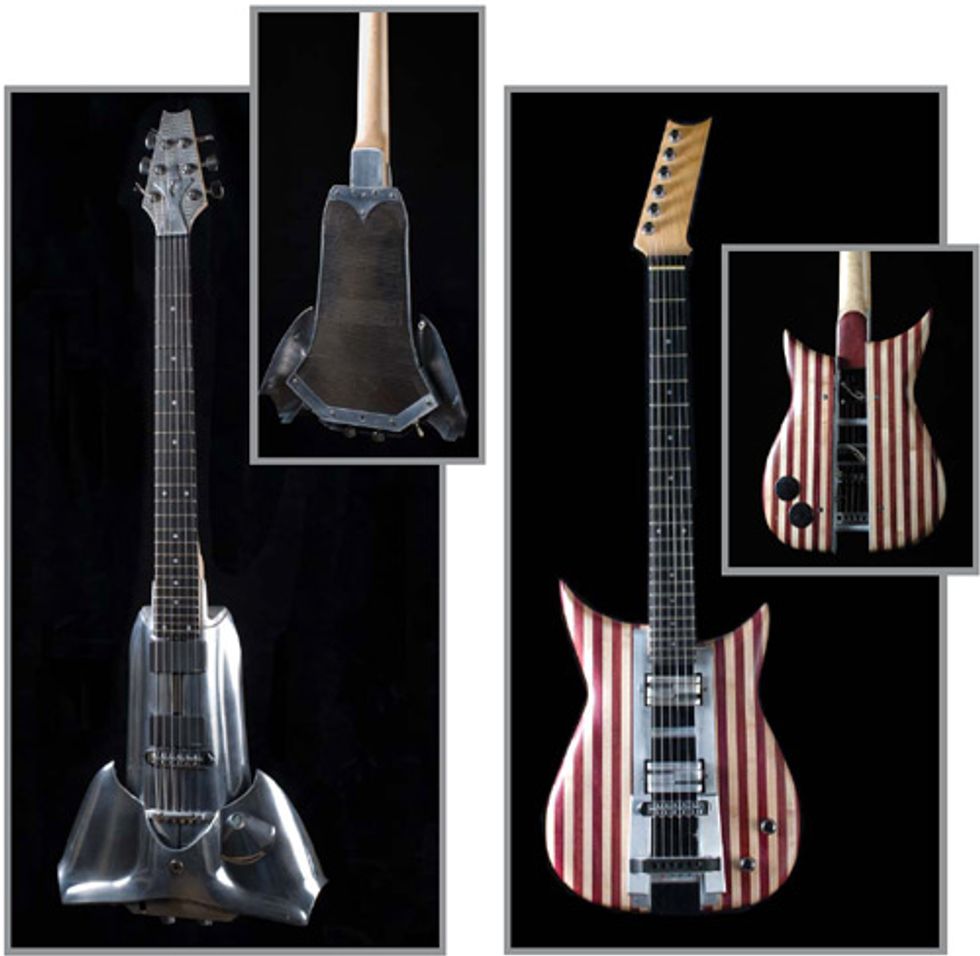Anibal Mistorni of AM Guitars is building guitars from vintage chrome vacuum cleaners
Using unconventional methods to make guitar bodies is nothing new
for luthiers and guitar companies. As recently as 2004, Flaxwood
broke new ground with their wood-based resin, injected molded guitars
and necks that avoid traditional woods altogether. And composite builders
have been honing the sound potential of carbon fiber for years. But for
Anibal Mistorni of AM Guitars—housed in Rudy’s Music in New York
City—building guitars from vintage chrome vacuum cleaners was more out
of an avant-garde, creative challenge than preventing tropical deforestation.
“It was either throw it away or do something with it,” laughs Mistorni.
“The something turned out to be AM’s first guitar.” Other AM Guitars have
come from resurrected motorcycle carburetors, aluminum from a late-1960s
Boeing airplane, a defunct golf cart, and the intake manifold from a BMW
engine. “The idea of using less than traditional designs was there right from
the start,” says Mistorni. “From that first guitar onwards I was hooked.
[Laughs.] It seemed like every object I encountered was begging to be made
into an instrument.”
There’s more to AM Guitars than Mistorni’s junkyard brainchilds. For
those who keep a foot firmly placed in the ’50s and ’60s, he builds some
models inspired by designs from 20th century guitar icons like the Gibson
Les Paul and Rickenbacker 330. These more standard models feature wood-based
bodies that are constructed from recycled hardwood floors—including
walnut, maple, and cherry—that are found all over NYC. Mistorni also
handcrafts his own bridges and tailpieces.
There is a glass ceiling to Mistorni’s Frankensteinian ways. He
knows that no matter the body material or shape there is only so much
deviation from convention he can undertake before guitarists shun his
instruments. “The only thing I haven’t really played with is the neck—
it’s the foundation of a good guitar. The neck is my blank canvas,” says
Mistorni. “I could come up with the most radical design, but if the
neck doesn’t play right, the guitar just becomes a piece of art, which
was never the point.” And just like any other luthier it comes down to
three simple things. “As much as I want my instruments to challenge
the way people think about guitar designs, I also want them to play
great, sound good, and feel comfortable.”

The Electric Beamer II
Photos by Vincent Ricardel
The Electric Beamer II
Mistorni describes the Electric Beamer II as being an “amazing accident.” He stumbled upon the guitar’s body—a BMW’s engine intake manifold—while wandering through a local junkyard. Classical nylon guitars inspired the woodworking on its walnut wings—built out of salvaged pieces of flooring—that surround the intake manifold. The maple neck with an ebony fingerboard runs through the body and features a custom aluminum logo on its headstock. It also has a Gotoh hardtail bridge, EMG active humbuckers, and Planet Waves auto-trim locking tuners.

LEFT: The V-Wing RIGHT: The Ricken
Photos by Vincent Ricardel
V-Wing
The V-Wing model is an extreme example of AM Guitars’ Doc Brown-style crazy-kooky ingenuity. It’s made out of a recycled aluminum grid and frame-plate of a vintage vacuum cleaner. Now looking more like a gladiator’s weapon than a vacuum cleaner, this battle-worthy axe features a 25 1/2" scale maple neck matched with an ebony fingerboard. The V-Wing also has a custom bridge and tailpiece, and is loaded with EMG pickups because he considers active pickups well suited to projects lacking wood “where I can’t count on the resonance of the wood to deliver solid tone.”
The Ricken
With its big, voluptuous body reminiscent of a ’60s Rickenbacker 330, the Ricken is a perfect name for this subdued-but-quirky AM Guitars creation. The body features maple and cherry woods that were recycled from old neighborhood floors. The skeleton is shaped out of aluminum, which is also used for the AM Guitars headstock logo. The Ricken also features Seymour Duncan humbuckers, custom electronics, a Schaller bridge, a custom-made tailpiece, and Sperzel tuners.
Pricing and Availability
Mistorni’s handbuilt, one-off guitars range anywhere from $5000–$20,000 depending on the value of the guitar’s materials and the hours spent building them. AM Guitars is a one-man shop so Mistorni welcomes all challenges and ideas from players. “I try to make each guitar a one of a kind piece of art,” says Mistorni. “I use customers’ input and materials so even if I’m using similar materials or objects, the guitars are constantly evolving in new directions both sonically and aesthetically ensuring each project is unique and different.” Currently, AM Guitars’ wait time is five months.
amguitars.rudysmusic.com
